coolant RENAULT SCENIC 2009 J84 / 2.G Engine And Peripherals EDC16 Workshop Manual
[x] Cancel search | Manufacturer: RENAULT, Model Year: 2009, Model line: SCENIC, Model: RENAULT SCENIC 2009 J84 / 2.GPages: 273
Page 9 of 273
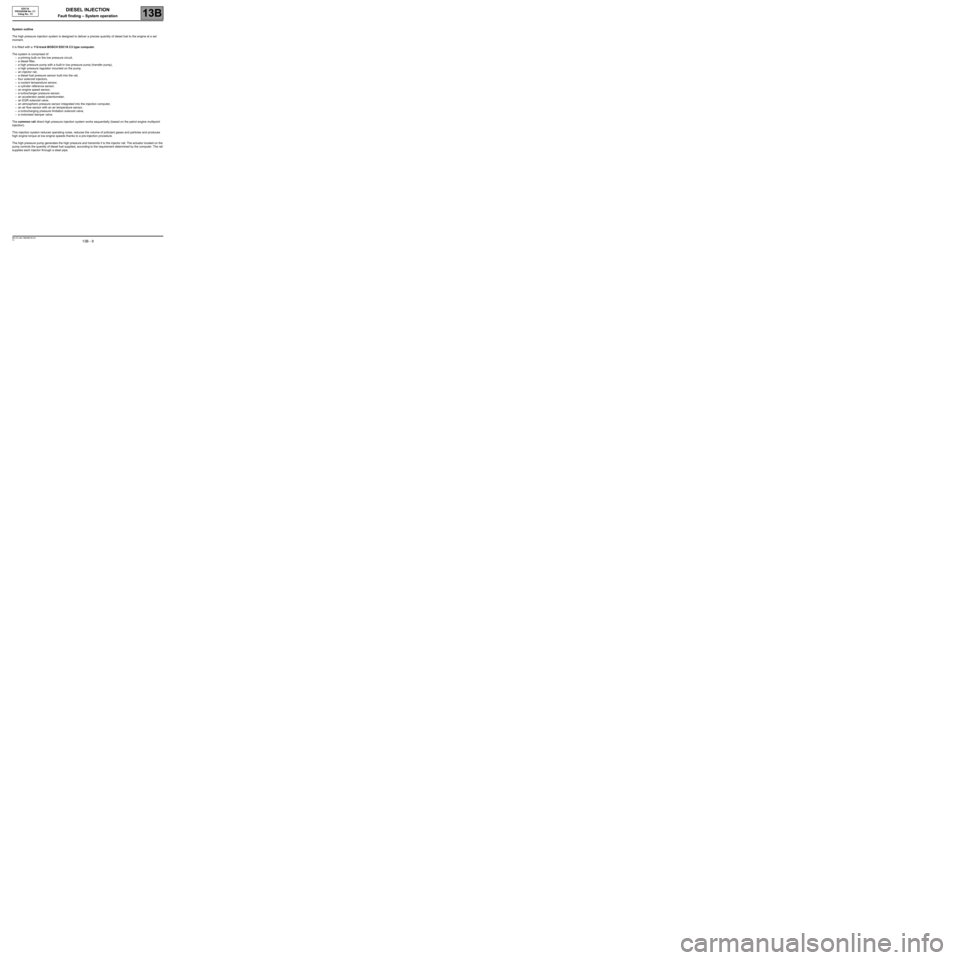
DIESEL INJECTION
Fault finding – System operation13B
13B - 9V3 MR-372-J84-13B250$135.mif
EDC16
PROGRAM No: C1
Vdiag No.: 51DIESEL INJECTION
Fault finding – System operation
System outline
The high pressure injection system is designed to deliver a precise quantity of diesel fuel to the engine at a set
moment.
It is fitted with a 112-track BOSCH EDC16 C3 type computer.
The system is comprised of:
–a priming bulb on the low pressure circuit,
–a diesel filter,
–a high pressure pump with a built-in low pressure pump (transfer pump),
–a high pressure regulator mounted on the pump,
–an injector rail,
–a diesel fuel pressure sensor built into the rail,
–four solenoid injectors,
–a coolant temperature sensor,
–a cylinder reference sensor,
–an engine speed sensor,
–a turbocharger pressure sensor,
–an accelerator pedal potentiometer,
–an EGR solenoid valve,
–an atmospheric pressure sensor integrated into the injection computer,
–an air flow sensor with an air temperature sensor,
–a turbocharging pressure limitation solenoid valve,
–a motorised damper valve.
The common rail direct high pressure injection system works sequentially (based on the petrol engine multipoint
injection).
This injection system reduces operating noise, reduces the volume of pollutant gases and particles and produces
high engine torque at low engine speeds thanks to a pre-injection procedure.
The high pressure pump generates the high pressure and transmits it to the injector rail. The actuator located on the
pump controls the quantity of diesel fuel supplied, according to the requirement determined by the computer. The rail
supplies each injector through a steel pipe.
MR-372-J84-13B250$135.mif
Page 10 of 273
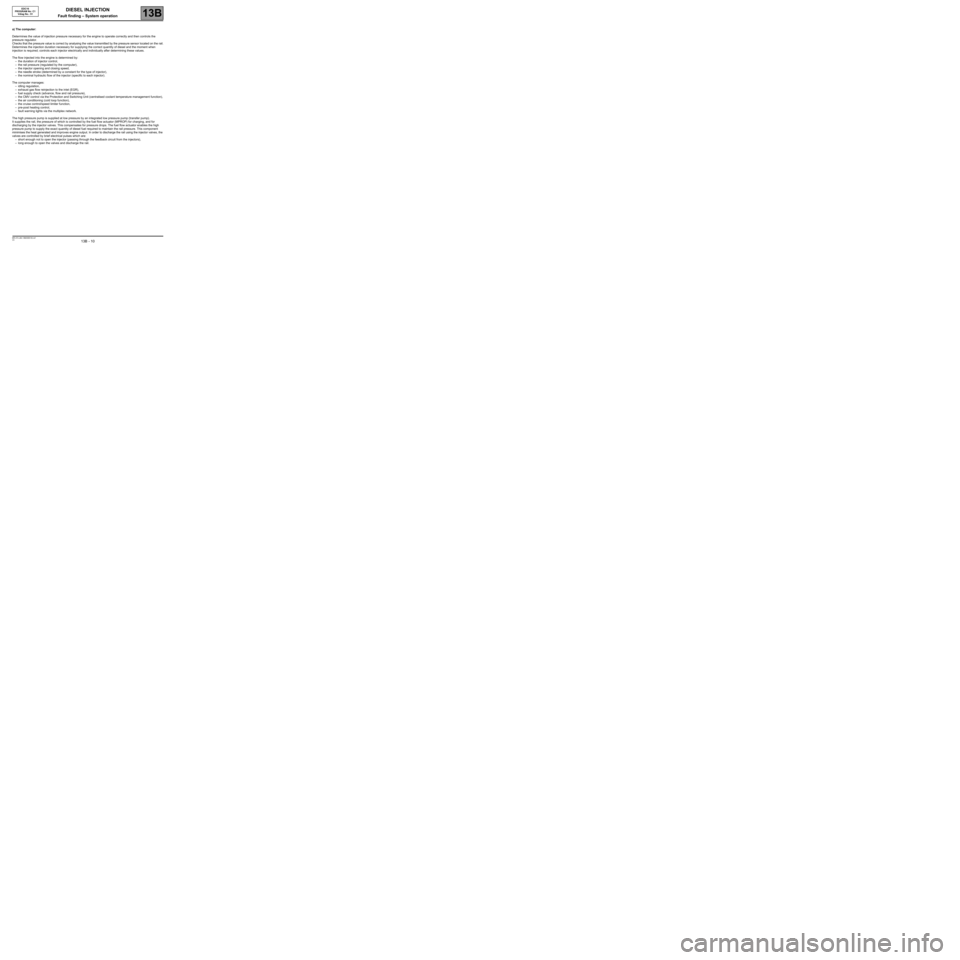
DIESEL INJECTION
Fault finding – System operation13B
13B - 10V3 MR-372-J84-13B250$135.mif
EDC16
PROGRAM No: C1
Vdiag No.: 51
a) The computer:
Determines the value of injection pressure necessary for the engine to operate correctly and then controls the
pressure regulator.
Checks that the pressure value is correct by analysing the value transmitted by the pressure sensor located on the rail.
Determines the injection duration necessary for supplying the correct quantity of diesel and the moment when
injection is required; controls each injector electrically and individually after determining these values.
The flow injected into the engine is determined by:
–the duration of injector control,
–the rail pressure (regulated by the computer),
–the injector opening and closing speed,
–the needle stroke (determined by a constant for the type of injector),
–the nominal hydraulic flow of the injector (specific to each injector).
The computer manages:
–idling regulation,
–exhaust gas flow reinjection to the inlet (EGR),
–fuel supply check (advance, flow and rail pressure),
–the CMV control via the Protection and Switching Unit (centralised coolant temperature management function),
–the air conditioning (cold loop function),
–the cruise control/speed limiter function,
–pre-post heating control,
–fault warning lights via the multiplex network.
The high pressure pump is supplied at low pressure by an integrated low pressure pump (transfer pump).
It supplies the rail, the pressure of which is controlled by the fuel flow actuator (MPROP) for charging, and for
discharging by the injector valves. This compensates for pressure drops. The fuel flow actuator enables the high
pressure pump to supply the exact quantity of diesel fuel required to maintain the rail pressure. This component
minimises the heat generated and improves engine output. In order to discharge the rail using the injector valves, the
valves are controlled by brief electrical pulses which are:
–short enough not to open the injector (passing through the feedback circuit from the injectors),
–long enough to open the valves and discharge the rail.
Page 12 of 273
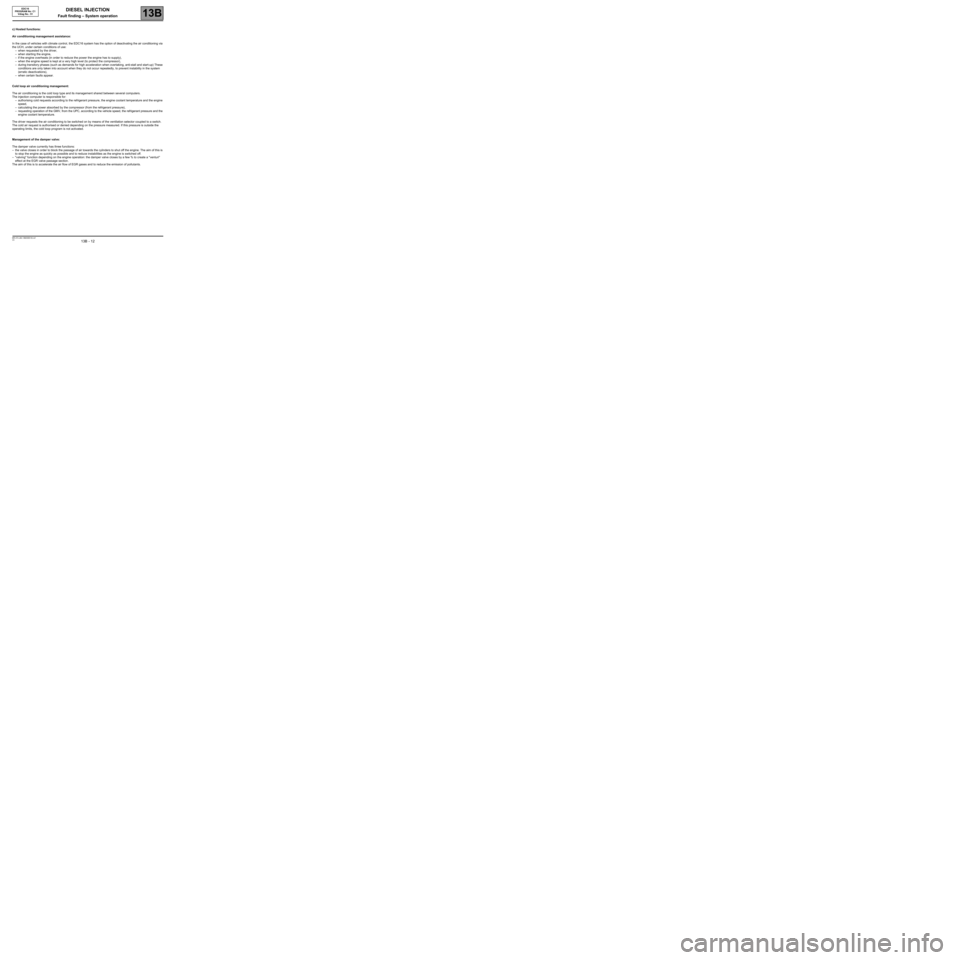
DIESEL INJECTION
Fault finding – System operation13B
13B - 12V3 MR-372-J84-13B250$135.mif
EDC16
PROGRAM No: C1
Vdiag No.: 51
c) Hosted functions:
Air conditioning management assistance:
In the case of vehicles with climate control, the EDC16 system has the option of deactivating the air conditioning via
the UCH, under certain conditions of use:
–when requested by the driver,
–when starting the engine,
–if the engine overheats (in order to reduce the power the engine has to supply),
–when the engine speed is kept at a very high level (to protect the compressor),
–during transitory phases (such as demands for high acceleration when overtaking, anti-stall and start-up) These
conditions are only taken into account when they do not occur repeatedly, to prevent instability in the system
(erratic deactivations),
–when certain faults appear.
Cold loop air conditioning management:
The air conditioning is the cold loop type and its management shared between several computers.
The injection computer is responsible for:
–authorising cold requests according to the refrigerant pressure, the engine coolant temperature and the engine
speed,
–calculating the power absorbed by the compressor (from the refrigerant pressure),
–requesting operation of the GMV, from the UPC, according to the vehicle speed, the refrigerant pressure and the
engine coolant temperature.
The driver requests the air conditioning to be switched on by means of the ventilation selector coupled to a switch.
The cold air request is authorised or denied depending on the pressure measured. If this pressure is outside the
operating limits, the cold loop program is not activated.
Management of the damper valve:
The damper valve currently has three functions:
–the valve closes in order to block the passage of air towards the cylinders to shut off the engine. The aim of this is
to stop the engine as quickly as possible and to reduce instabilities as the engine is switched off.
–"valving" function depending on the engine operation: the damper valve closes by a few % to create a ''venturi''
effect at the EGR valve passage section.
The aim of this is to accelerate the air flow of EGR gases and to reduce the emission of pollutants.
Page 14 of 273
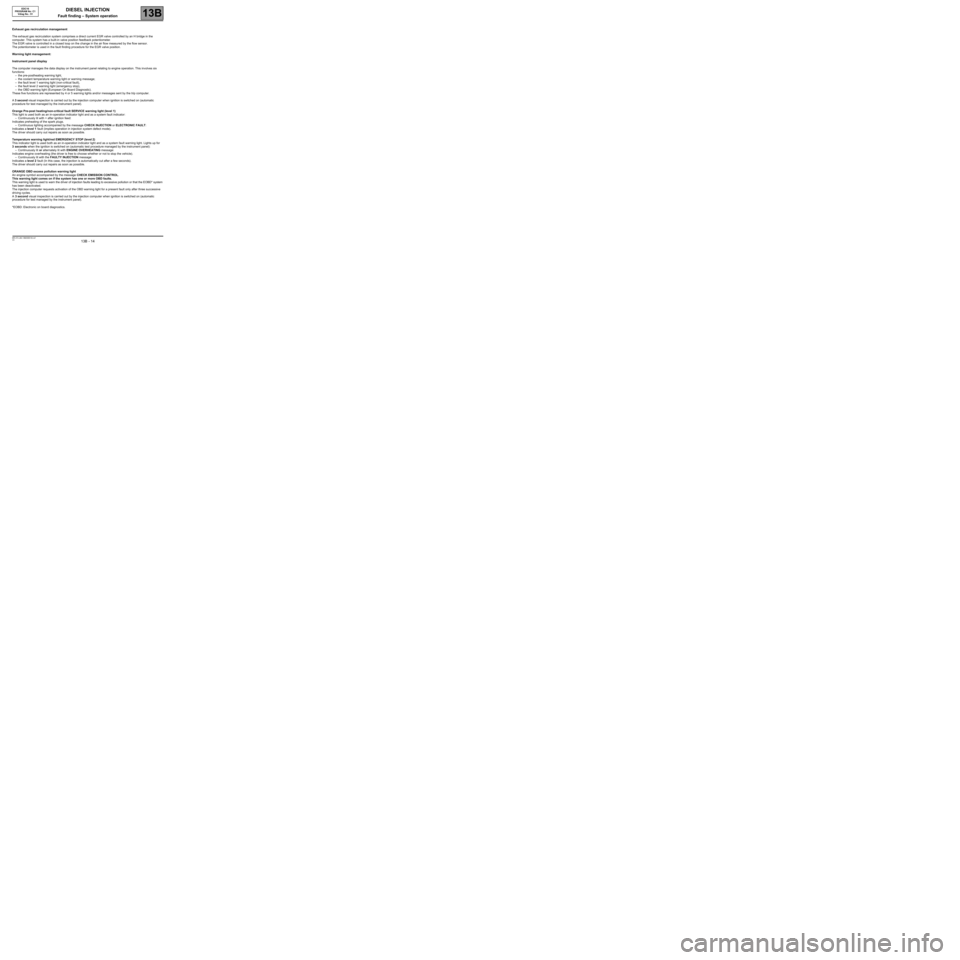
DIESEL INJECTION
Fault finding – System operation13B
13B - 14V3 MR-372-J84-13B250$135.mif
EDC16
PROGRAM No: C1
Vdiag No.: 51
Exhaust gas recirculation management
The exhaust gas recirculation system comprises a direct current EGR valve controlled by an H bridge in the
computer. This system has a built-in valve position feedback potentiometer.
The EGR valve is controlled in a closed loop on the change in the air flow measured by the flow sensor.
The potentiometer is used in the fault finding procedure for the EGR valve position.
Warning light management:
Instrument panel display
The computer manages the data display on the instrument panel relating to engine operation. This involves six
functions:
–the pre-postheating warning light,
–the coolant temperature warning light or warning message;
–the fault level 1 warning light (non-critical fault),
–the fault level 2 warning light (emergency stop),
–the OBD warning light (European On Board Diagnostic).
These five functions are represented by 4 or 5 warning lights and/or messages sent by the trip computer.
A 3 second visual inspection is carried out by the injection computer when ignition is switched on (automatic
procedure for test managed by the instrument panel).
Orange Pre-post heating/non-critical fault SERVICE warning light (level 1)
This light is used both as an in-operation indicator light and as a system fault indicator:
–Continuously lit with + after ignition feed:
Indicates preheating of the spark plugs.
–Continuous lighting accompanied by the message CHECK INJECTION or ELECTRONIC FAULT:
Indicates a level 1 fault (implies operation in injection system defect mode).
The driver should carry out repairs as soon as possible.
Temperature warning light/red EMERGENCY STOP (level 2)
This indicator light is used both as an in-operation indicator light and as a system fault warning light. Lights up for
3 seconds when the ignition is switched on (automatic test procedure managed by the instrument panel):
–Continuously lit or alternately lit with ENGINE OVERHEATING message:
Indicates engine overheating (the driver is free to choose whether or not to stop the vehicle).
–Continuously lit with the FAULTY INJECTION message:
Indicates a level 2 fault (In this case, the injection is automatically cut after a few seconds).
The driver should carry out repairs as soon as possible.
ORANGE OBD excess pollution warning light
An engine symbol accompanied by the message CHECK EMISSION CONTROL.
This warning light comes on if the system has one or more OBD faults.
This warning light is used to warn the driver of injection faults leading to excessive pollution or that the EOBD* system
has been deactivated.
The injection computer requests activation of the OBD warning light for a present fault only after three successive
driving cycles.
A 3 second visual inspection is carried out by the injection computer when ignition is switched on (automatic
procedure for test managed by the instrument panel).
*EOBD: Electronic on board diagnostics.
Page 15 of 273
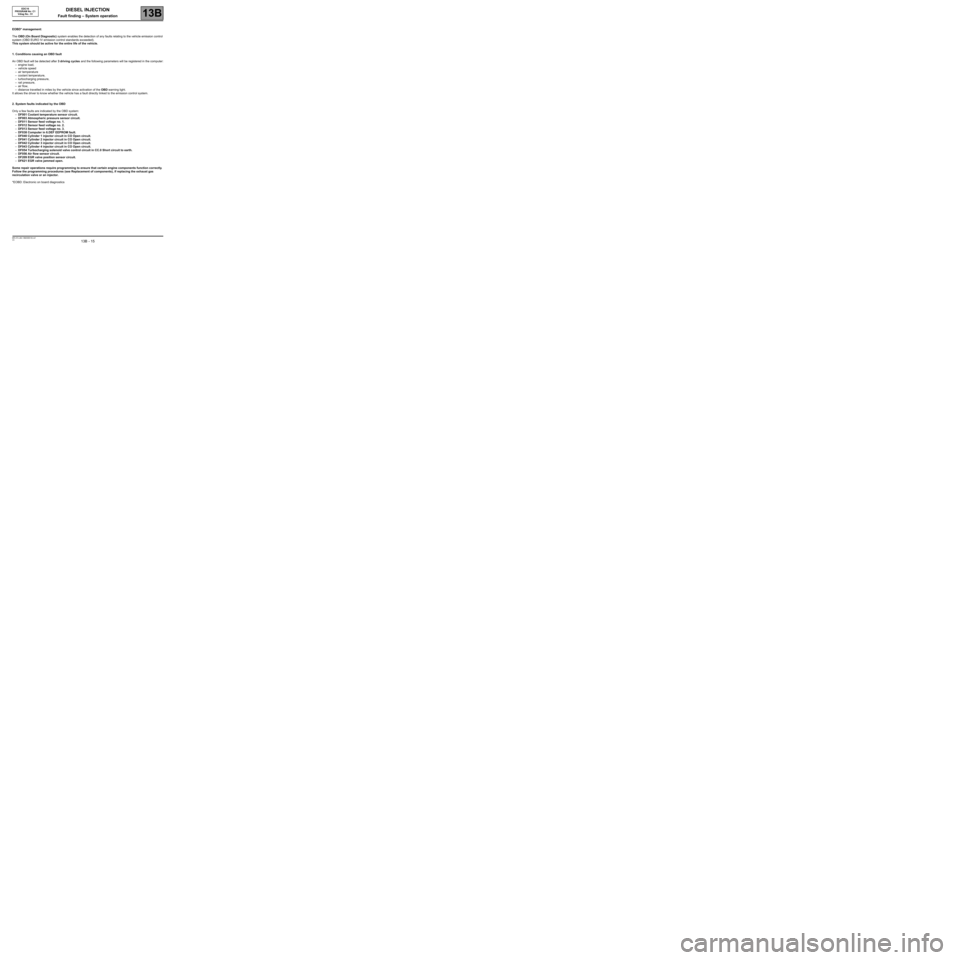
DIESEL INJECTION
Fault finding – System operation13B
13B - 15V3 MR-372-J84-13B250$135.mif
EDC16
PROGRAM No: C1
Vdiag No.: 51
EOBD* management:
The OBD (On Board Diagnostic) system enables the detection of any faults relating to the vehicle emission control
system (OBD EURO IV emission control standards exceeded).
This system should be active for the entire life of the vehicle.
1. Conditions causing an OBD fault
An OBD fault will be detected after 3 driving cycles and the following parameters will be registered in the computer:
–engine load,
–vehicle speed
–air temperature
–coolant temperature,
–turbocharging pressure,
–rail pressure,
–air flow,
–distance travelled in miles by the vehicle since activation of the OBD warning light.
It allows the driver to know whether the vehicle has a fault directly linked to the emission control system.
2. System faults indicated by the OBD
Only a few faults are indicated by the OBD system:
–DF001 Coolant temperature sensor circuit.
–DF003 Atmospheric pressure sensor circuit.
–DF011 Sensor feed voltage no. 1.
–DF012 Sensor feed voltage no. 2.
–DF013 Sensor feed voltage no. 3.
–DF038 Computer in 6.DEF EEPROM fault.
–DF040 Cylinder 1 injector circuit in CO Open circuit.
–DF041 Cylinder 2 injector circuit in CO Open circuit.
–DF042 Cylinder 3 injector circuit in CO Open circuit.
–DF043 Cylinder 4 injector circuit in CO Open circuit.
–DF054 Turbocharging solenoid valve control circuit in CC.0 Short circuit to earth.
–DF056 Air flow sensor circuit.
–DF209 EGR valve position sensor circuit.
–DF621 EGR valve jammed open.
Some repair operations require programming to ensure that certain engine components function correctly.
Follow the programming procedures (see Replacement of components), if replacing the exhaust gas
recirculation valve or an injector.
*EOBD: Electronic on board diagnostics
Page 16 of 273

DIESEL INJECTION
Fault finding – System operation13B
13B - 16V3 MR-372-J84-13B250$135.mif
EDC16
PROGRAM No: C1
Vdiag No.: 51
3. Conditions for clearing an OBD fault
An OBD fault is cleared in several steps.
The fault present in the diagnostic tool is not stored (following repair) until after 3 trips with the vehicle.
The OBD warning light will only light up after these 3 driving cycles.
The warning light coming on does not always mean that there is a fault on the system.
In order that the OBD fault and the display parameters are cleared from the computer, the system needs to
go through 40 engine heating cycles.
An engine heating cycle is a driving cycle during which:
–the engine coolant temperature reaches at least 71.1 ˚C,
–the engine coolant temperature varies by 22.2 °C in relation to the engine starting temperature.
If one of these conditions is not fulfilled, the OBD fault will still be present or stored in the injection computer.
Page 18 of 273
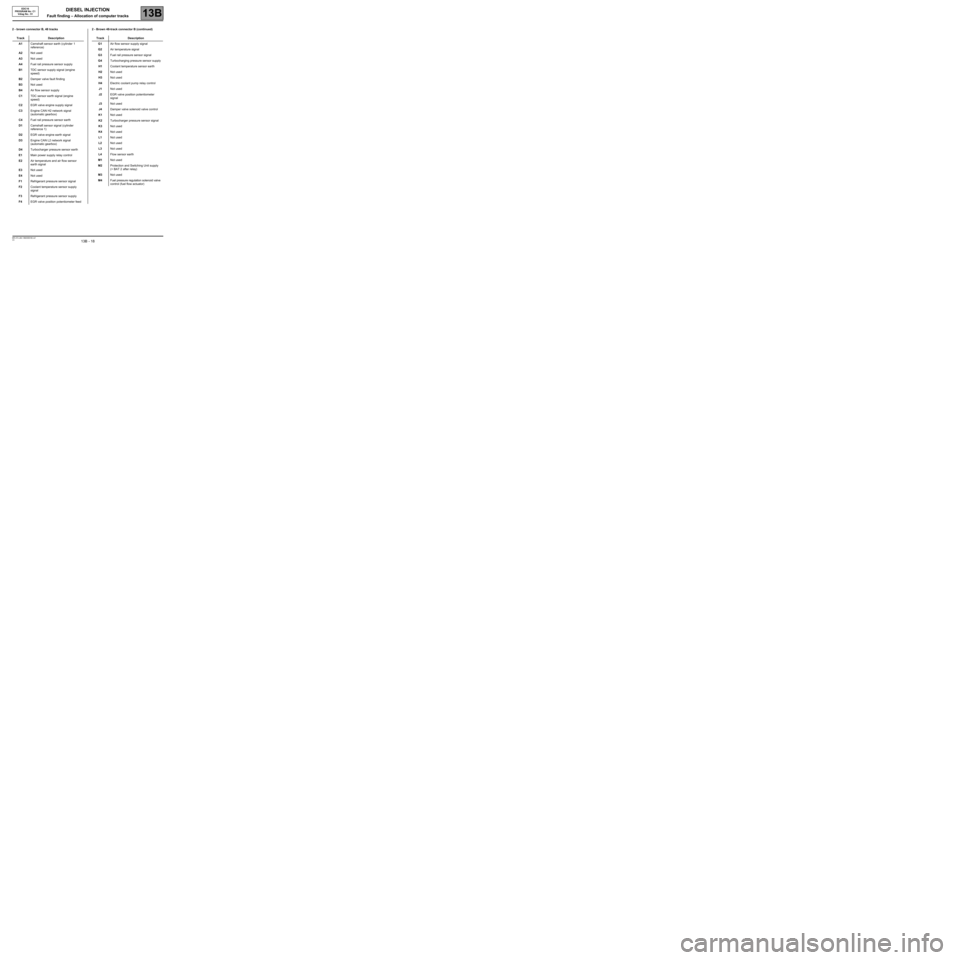
DIESEL INJECTION
Fault finding – Allocation of computer tracks13B
13B - 18V3 MR-372-J84-13B250$180.mif
EDC16
PROGRAM No: C1
Vdiag No.: 51
2 - brown connector B, 48 tracks 2 - Brown 48-track connector B (continued)
Track Description
A1Camshaft sensor earth (cylinder 1
reference)
A2Not used
A3Not used
A4Fuel rail pressure sensor supply
B1TDC sensor supply signal (engine
speed)
B2Damper valve fault finding
B3Not used
B4Air flow sensor supply
C1TDC sensor earth signal (engine
speed)
C2EGR valve engine supply signal
C3Engine CAN H2 network signal
(automatic gearbox)
C4Fuel rail pressure sensor earth
D1Camshaft sensor signal (cylinder
reference 1)
D2EGR valve engine earth signal
D3Engine CAN L2 network signal
(automatic gearbox)
D4Turbocharger pressure sensor earth
E1Main power supply relay control
E2Air temperature and air flow sensor
earth signal
E3Not used
E4Not used
F1Refrigerant pressure sensor signal
F2Coolant temperature sensor supply
signal
F3Refrigerant pressure sensor supply
F4EGR valve position potentiometer feed
Track Description
G1Air flow sensor supply signal
G2Air temperature signal
G3Fuel rail pressure sensor signal
G4Turbocharging pressure sensor supply
H1Coolant temperature sensor earth
H2Not used
H3Not used
H4Electric coolant pump relay control
J1Not used
J2EGR valve position potentiometer
signal
J3Not used
J4Damper valve solenoid valve control
K1Not used
K2Turbocharger pressure sensor signal
K3Not used
K4Not used
L1Not used
L2Not used
L3Not used
L4Flow sensor earth
M1Not used
M2Protection and Switching Unit supply
(+ BAT 2 after relay)
M3Not used
M4Fuel pressure regulation solenoid valve
control (fuel flow actuator)
Page 20 of 273
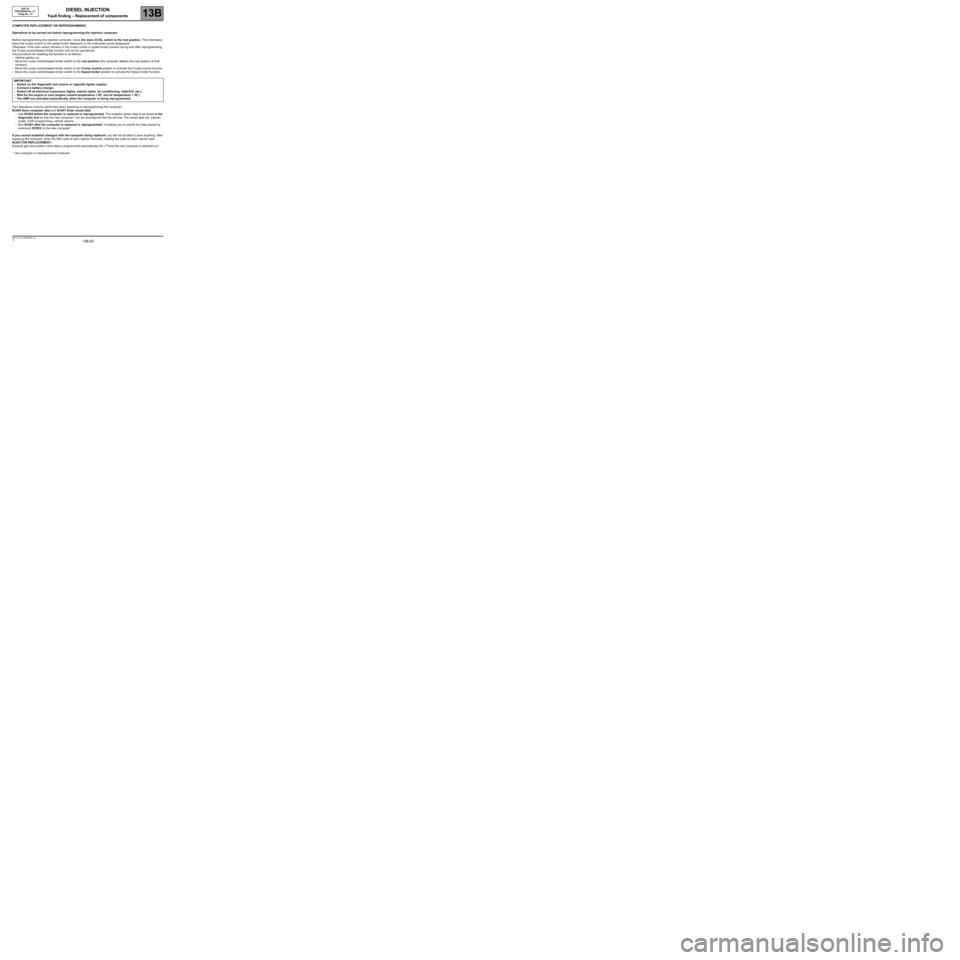
DIESEL INJECTION
Fault finding – Replacement of components13B
13B-20V3 MR-372-J84-13B250$225.mif
EDC16
PROGRAM No: C1
Vdiag No.: 51DIESEL INJECTION
Fault finding – Replacement of components
COMPUTER REPLACEMENT OR REPROGRAMMING
Operations to be carried out before reprogramming the injection computer:
Before reprogramming the injection computer, move the main CC/SL switch to the rest position. The information
about the cruise control or the speed limiter displayed on the instrument panel disappears.
Otherwise, if the main switch remains in the cruise control or speed limiter position during and after reprogramming,
the Cruise control/Speed limiter function will not be operational.
The procedure for resetting the function is as follows:
–Vehicle ignition on.
–Move the cruise control/speed limiter switch to the rest position (the computer detects the rest position at that
moment).
–Move the cruise control/speed limiter switch to the Cruise control position to activate the Cruise control function.
–Move the cruise control/speed limiter switch to the Speed limiter position to activate the Speed limiter function.
Two operations must be performed when replacing or reprogramming the computer:
SC003 Save computer data and SC001 Enter saved data.
–Use SC003 before the computer is replaced or reprogrammed. This enables certain data to be saved in the
diagnostic tool so that the new computer* can be reconfigured like the old one. The saved data are: injector
codes, EGR programming, vehicle options.
–Run SC001 after the computer is replaced or reprogrammed. It enables you to rewrite the data (saved by
command SC003) to the new computer*.
If you cannot establish dialogue with the computer being replaced: you will not be able to save anything. After
replacing the computer, enter the IMA code of each injector manually, reading the code on each injector (see
INJECTOR REPLACEMENT).
Exhaust gas recirculation valve data is programmed automatically the 1
st time the new computer is switched on*.
* new computer or reprogrammed computer. IMPORTANT
–Switch on the diagnostic tool (mains or cigarette lighter supply).
–Connect a battery charger.
–Switch off all electrical consumers (lights, interior lights, air conditioning, radio/CD, etc.).
–Wait for the engine to cool (engine coolant temperature < 60˚ and air temperature < 50˚).
–The GMV are activated automatically when the computer is being reprogrammed.
Page 26 of 273
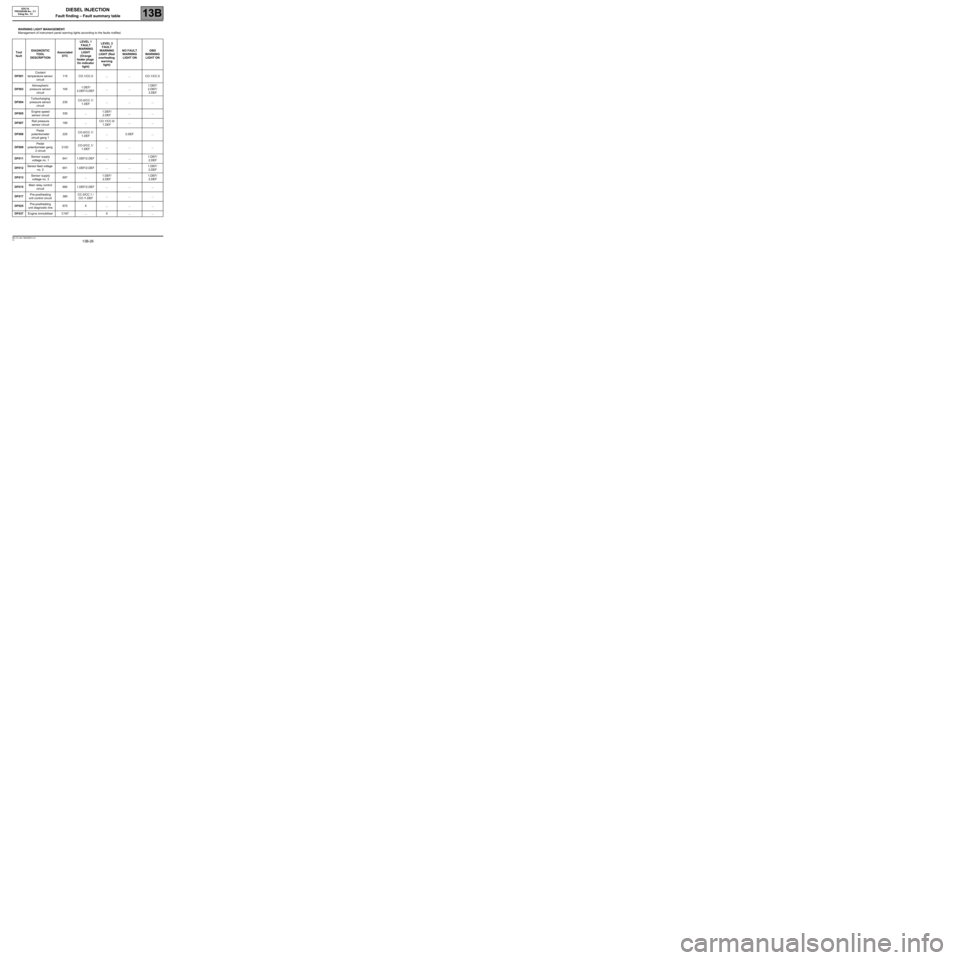
DIESEL INJECTION
Fault finding – Fault summary table13B
13B-26V3 MR-372-J84-13B250$270.mif
EDC16
PROGRAM No.: C1
Vdiag No.: 51DIESEL INJECTION
Fault finding – Fault summary table
WARNING LIGHT MANAGEMENT:
Management of instrument panel warning lights according to the faults notified.
Tool
faultDIAGNOSTIC
TOOL
DESCRIPTIONAssociated
DTCLEVEL 1
FAULT
WARNING
LIGHT
(Orange
heater plugs
On indicator
light)LEVEL 2
FAULT
WARNING
LIGHT (Red
overheating
warning
light)NO FAULT
WARNING
LIGHT ONOBD
WARNING
LIGHT ON
DF001Coolant
temperature sensor
circuit115 CO.1/CC.0 ... ... CO.1/CC.0
DF003Atmospheric
pressure sensor
circuit1051.DEF/
2.DEF/3.DEF... ...1.DEF/
2.DEF/
3.DEF
DF004Turbocharging
pressure sensor
circuit235CO.0/CC.1/
1.DEF... ... ...
DF005Engine speed
sensor circuit335 ...1.DEF/
2.DEF... ...
DF007Rail pressure
sensor circuit190 ...CO.1/CC.0/
1.DEF... ...
DF008Pedal
potentiometer
circuit gang 1225CO.0/CC.1/
1.DEF... 2.DEF ...
DF009Pedal
potentiometer gang
2 circuit2120CO.0/CC.1/
1.DEF... ... ...
DF011Sensor supply
voltage no. 1641 1.DEF/2.DEF ... ...1.DEF/
2.DEF
DF012Sensor feed voltage
no. 2651 1.DEF/2.DEF ... ...1.DEF/
2.DEF
DF013Sensor supply
voltage no. 3697 ...1.DEF/
2.DEF...1.DEF/
2.DEF
DF015Main relay control
circuit685 1.DEF/2.DEF ... ... ...
DF017Pre-postheating
unit control circuit380CC.0/CC.1 /
CO /1.DEF... ... ...
DF025Pre-postheating
unit diagnostic line670 X ... ... ...
DF037Engine immobiliser C167 ... X ... ...
Page 28 of 273
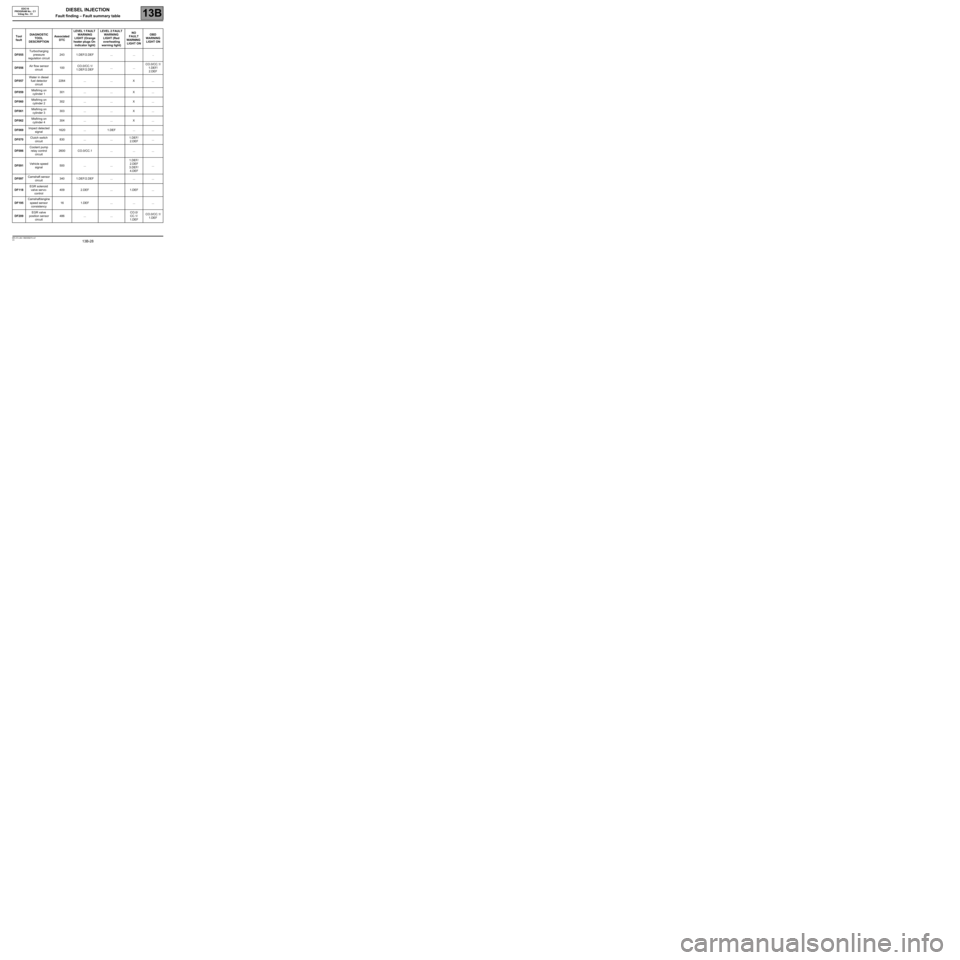
DIESEL INJECTION
Fault finding – Fault summary table13B
13B-28V3 MR-372-J84-13B250$270.mif
EDC16
PROGRAM No.: C1
Vdiag No.: 51
Tool
faultDIAGNOSTIC
TOOL
DESCRIPTIONAssociated
DTCLEVEL 1 FAULT
WARNING
LIGHT (Orange
heater plugs On
indicator light)LEVEL 2 FAULT
WARNING
LIGHT (Red
overheating
warning light)NO
FAULT
WARNING
LIGHT ONOBD
WARNING
LIGHT ON
DF055Turbocharging
pressure
regulation circuit243 1.DEF/2.DEF ... ... ..
DF056Air flow sensor
circuit100CO.0/CC.1/
1.DEF/2.DEF... ...CO.0/CC.1/
1.DEF/
2.DEF
DF057Water in diesel
fuel detector
circuit2264 ... ... X ...
DF059Misfiring on
cylinder 1301 ... ... X ...
DF060Misfiring on
cylinder 2302 ... ... X ...
DF061Misfiring on
cylinder 3303 ... ... X ...
DF062Misfiring on
cylinder 4304 ... ... X ...
DF069Impact detected
signal1620 ... 1.DEF ... ...
DF070Clutch switch
circuit830 ... ...1.DEF/
2.DEF...
DF086Coolant pump
relay control
circuit2600 CO.0/CC.1 ... ... ...
DF091Vehicle speed
signal500 ... ...1.DEF/
2.DEF
3.DEF/
4.DEF ...
DF097Camshaft sensor
circuit340 1.DEF/2.DEF ... ... ...
DF118EGR solenoid
valve servo-
control409 2.DEF ... 1.DEF ...
DF195Camshaft/engine
speed sensor
consistency16 1.DEF ... ... ...
DF209EGR valve
position sensor
circuit486 ... ...CO.0/
CC.1/
1.DEFCO.0/CC.1/
1.DEF